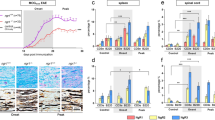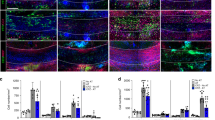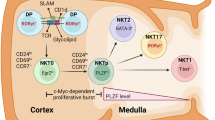Abstract
During brain development, the immune system mediates neurogenesis, gliogenesis and synapse formation. However, it remains unclear whether peripheral lymphocytes contribute to brain development. Here we identified the subtypes of lymphocytes that are present in neonatal mouse brains and investigated their functions. We found that B-1a cells, a subtype of B cells, were abundant in the neonatal mouse brain and infiltrated into the brain in a CXCL13–CXCR5-dependent manner. B-1a cells promoted the proliferation of oligodendrocyte-precursor cells (OPCs) in vitro, and depletion of B-1a cells from developing brains resulted in a reduction of numbers of OPCs and mature oligodendrocytes. Furthermore, neutralizing Fcα/μR, the receptor for the Fc region of IgM secreted by B-1a cells, inhibited OPC proliferation and reduced the proportion of myelinated axons in neonatal mouse brains. Our results demonstrate that B-1a cells infiltrate into the brain and contribute to oligodendrogenesis and myelination by promoting OPC proliferation via IgM–Fcα/μR signaling.
This is a preview of subscription content, access via your institution
Access options
Access Nature and 54 other Nature Portfolio journals
Get Nature+, our best-value online-access subscription
$29.99 / 30 days
cancel any time
Subscribe to this journal
Receive 12 print issues and online access
$209.00 per year
only $17.42 per issue
Buy this article
- Purchase on Springer Link
- Instant access to full article PDF
Prices may be subject to local taxes which are calculated during checkout







Similar content being viewed by others
References
Emery, B. Regulation of oligodendrocyte differentiation and myelination. Science 330, 779–782 (2010).
Nave, K. A. Myelination and the trophic support of long axons. Nat. Rev. Neurosci. 11, 275–283 (2010).
Zhang, S. C. Defining glial cells during CNS development. Nat. Rev. Neurosci. 2, 840–843 (2001).
Calver, A. R. et al. Oligodendrocyte population dynamics and the role of PDGF in vivo. Neuron 20, 869–882 (1998).
Nakahara, J. et al. Signaling via immunoglobulin Fc receptors induces oligodendrocyte precursor cell differentiation. Dev. Cell 4, 841–852 (2003).
Weiss, J. et al. Neonatal hypoxia suppresses oligodendrocyte Nogo-A and increases axonal sprouting in a rodent model for human prematurity. Exp. Neurol. 189, 141–149 (2004).
Yuen, T. J. et al. Oligodendrocyte-encoded HIF function couples postnatal myelination and white matter angiogenesis. Cell 158, 383–396 (2014).
Katsel, P., Davis, K. L. & Haroutunian, V. Variations in myelin and oligodendrocyte-related gene expression across multiple brain regions in schizophrenia: a gene ontology study. Schizophr. Res. 79, 157–173 (2005).
Cunningham, C. L., Martínez-Cerdeño, V. & Noctor, S. C. Microglia regulate the number of neural precursor cells in the developing cerebral cortex. J. Neurosci. 33, 4216–4233 (2013).
Shigemoto-Mogami, Y., Hoshikawa, K., Goldman, J. E., Sekino, Y. & Sato, K. Microglia enhance neurogenesis and oligodendrogenesis in the early postnatal subventricular zone. J. Neurosci. 34, 2231–2243 (2014).
Glynn, M. W. et al. MHCI negatively regulates synapse density during the establishment of cortical connections. Nat. Neurosci. 14, 442–451 (2011).
Xu, H. P. et al. The immune protein CD3zeta is required for normal development of neural circuits in the retina. Neuron 65, 503–515 (2010).
Derecki, N. C. et al. Regulation of learning and memory by meningeal immunity: a key role for IL-4. J. Exp. Med. 207, 1067–1080 (2010).
Filiano, A. J. et al. Unexpected role of interferon-γ in regulating neuronal connectivity and social behaviour. Nature 535, 425–429 (2016).
Estes, M. L. & McAllister, A. K. Immune mediators in the brain and peripheral tissues in autism spectrum disorder. Nat. Rev. Neurosci. 16, 469–486 (2015).
Smith, S. E., Li, J., Garbett, K., Mirnics, K. & Patterson, P. H. Maternal immune activation alters fetal brain development through interleukin-6. J. Neurosci. 27, 10695–10702 (2007).
Schizophrenia Working Group of the Psychiatric Genomics Consortium. Biological insights from 108 schizophrenia-associated genetic loci. Nature 511, 421–427 (2014).
Baumgarth, N. The double life of a B-1 cell: self-reactivity selects for protective effector functions. Nat. Rev. Immunol. 11, 34–46 (2011).
Tung, J. W., Mrazek, M. D., Yang, Y., Herzenberg, L. A. & Herzenberg, L. A. Phenotypically distinct B cell development pathways map to the three B cell lineages in the mouse. Proc. Natl Acad. Sci. USA 103, 6293–6298 (2006).
Montecino-Rodriguez, E. & Dorshkind, K. B-1 B cell development in the fetus and adult. Immunity 36, 13–21 (2012).
Montecino-Rodriguez, E. & Dorshkind, K. Formation of B-1 B cells from neonatal B-1 transitional cells exhibits NF-κB redundancy. J. Immunol. 187, 5712–5719 (2011).
Ansel, K. M., Harris, R. B. & Cyster, J. G. CXCL13 is required for B1 cell homing, natural antibody production, and body cavity immunity. Immunity 16, 67–76 (2002).
Bleul, C. C., Schultze, J. L. & Springer, T. A. B lymphocyte chemotaxis regulated in association with microanatomic localization, differentiation state, and B cell receptor engagement. J. Exp. Med. 187, 753–762 (1998).
Lehtinen, M. K. et al. The cerebrospinal fluid provides a proliferative niche for neural progenitor cells. Neuron 69, 893–905 (2011).
Zhang, J., Smith, D., Yamamoto, M., Ma, L. & McCaffery, P. The meninges is a source of retinoic acid for the late-developing hindbrain. J. Neurosci. 23, 7610–7620 (2003).
Siegenthaler, J. A. et al. Retinoic acid from the meninges regulates cortical neuron generation. Cell 139, 597–609 (2009).
Rauch, M., Tussiwand, R., Bosco, N. & Rolink, A. G. Crucial role for BAFF-BAFF-R signaling in the survival and maintenance of mature B cells. PLoS One 4, e5456 (2009).
Rolink, A. G., Tschopp, J., Schneider, P. & Melchers, F. BAFF is a survival and maturation factor for mouse B cells. Eur. J. Immunol. 32, 2004–2010 (2002).
Lin, W. Y. et al. Anti-BR3 antibodies: a new class of B-cell immunotherapy combining cellular depletion and survival blockade. Blood 110, 3959–3967 (2007).
Marshall, C. A., Novitch, B. G. & Goldman, J. E. Olig2 directs astrocyte and oligodendrocyte formation in postnatal subventricular zone cells. J. Neurosci. 25, 7289–7298 (2005).
Cahoy, J. D. et al. A transcriptome database for astrocytes, neurons, and oligodendrocytes: a new resource for understanding brain development and function. J. Neurosci. 28, 264–278 (2008).
Hayakawa, K., Hardy, R. R., Parks, D. R. & Herzenberg, L. A. The “Ly-1 B” cell subpopulation in normal immunodefective, and autoimmune mice. J. Exp. Med. 157, 202–218 (1983).
Shibuya, A. et al. Fc alpha/mu receptor mediates endocytosis of IgM-coated microbes. Nat. Immunol. 1, 441–446 (2000).
Nakahara, J., Seiwa, C., Shibuya, A., Aiso, S. & Asou, H. Expression of Fc receptor for immunoglobulin M in oligodendrocytes and myelin of mouse central nervous system. Neurosci. Lett. 337, 73–76 (2003).
Casola, S. et al. B cell receptor signal strength determines B cell fate. Nat. Immunol. 5, 317–327 (2004).
Goldmann, T. et al. Origin, fate and dynamics of macrophages at central nervous system interfaces. Nat. Immunol. 17, 797–805 (2016).
Ginhoux, F. et al. Fate mapping analysis reveals that adult microglia derive from primitive macrophages. Science 330, 841–845 (2010).
Ansel, K. M. et al. A chemokine-driven positive feedback loop organizes lymphoid follicles. Nature 406, 309–314 (2000).
Förster, R. et al. A putative chemokine receptor, BLR1, directs B cell migration to defined lymphoid organs and specific anatomic compartments of the spleen. Cell 87, 1037–1047 (1996).
Asakura, K., Miller, D. J., Pease, L. R. & Rodriguez, M. Targeting of IgMkappa antibodies to oligodendrocytes promotes CNS remyelination. J. Neurosci. 18, 7700–7708 (1998).
Miller, D. J., Sanborn, K. S., Katzmann, J. A. & Rodriguez, M. Monoclonal autoantibodies promote central nervous system repair in an animal model of multiple sclerosis. J. Neurosci. 14, 6230–6238 (1994).
Jalabi, W., Boehm, N., Grucker, D. & Ghandour, M. S. Recovery of myelin after induction of oligodendrocyte cell death in postnatal brain. J. Neurosci. 25, 2885–2894 (2005).
Dummula, K. et al. Bone morphogenetic protein inhibition promotes neurological recovery after intraventricular hemorrhage. J. Neurosci. 31, 12068–12082 (2011).
Sabo, J. K. et al. Olig1 is required for noggin-induced neonatal myelin repair. Ann. Neurol. 81, 560–571 (2017).
Hardy, R. J. & Friedrich, V. L. Jr. Oligodendrocyte progenitors are generated throughout the embryonic mouse brain, but differentiate in restricted foci. Development 122, 2059–2069 (1996).
Ashwood, P. et al. In search of cellular immunophenotypes in the blood of children with autism. PLoS One 6, e19299 (2011).
Herbert, M. R. et al. Localization of white matter volume increase in autism and developmental language disorder. Ann. Neurol. 55, 530–540 (2004).
Tkachev, D. et al. Oligodendrocyte dysfunction in schizophrenia and bipolar disorder. Lancet 362, 798–805 (2003).
Flynn, S. W. et al. Abnormalities of myelination in schizophrenia detected in vivo with MRI, and post-mortem with analysis of oligodendrocyte proteins. Mol. Psychiatry 8, 811–820 (2003).
Ebert, D. H. & Greenberg, M. E. Activity-dependent neuronal signalling and autism spectrum disorder. Nature 493, 327–337 (2013).
Chojnacki, A. & Weiss, S. Production of neurons, astrocytes and oligodendrocytes from mammalian CNS stem cells. Nat. Protoc. 3, 935–940 (2008).
Yamasaki, M., Matsui, M. & Watanabe, M. Preferential localization of muscarinic M1 receptor on dendritic shaft and spine of cortical pyramidal cells and its anatomical evidence for volume transmission. J. Neurosci. 30, 4408–4418 (2010).
Fay, M. P. & Proschan, M. A. Wilcoxon-Mann-Whitney or t-test? On assumptions for hypothesis tests and multiple interpretations of decision rules. Stat. Surv. 4, 1–39 (2010).
Acknowledgements
We thank M. Fujitani (Hyogo College of Medicine) and Y. Hayano (Max Planck Florida Institute for Neuroscience) for technical advice regarding the in utero injection and T. Takeda, S. Kayama and Y. Doi (Osaka University) for providing CD19-Cre mice. Hanaichi UltraStructure Research Institute (Aichi, Japan) prepared the tissue sections for electron microscopy. This work was supported by a Grant-in-Aid for Scientific Research (S) from the Japan Society for the Promotion of Sciences (17H06178) to T.Y. and a Grand-in-Aid for Young Scientists (B) from the Japan Society for the Promotion of Sciences (16K18394) to S.T.
Author information
Authors and Affiliations
Contributions
S.T. designed and performed the experiments and analyzed the data. T.Y. coordinated and directed the project. All authors wrote the manuscript.
Corresponding author
Ethics declarations
Competing interests
The authors declare no competing interests.
Additional information
Publisher's note: Springer Nature remains neutral with regard to jurisdictional claims in published maps and institutional affiliations.
Integrated supplementary information
Supplementary Figure 1 Flow-cytometry analysis of B cells in neonatal brain.
Data from flow cytometry that are summarized in Fig. 1a–b. Mononuclear cells from embryonic days E16, E18, postnatal days P1, P5, P10, P14, P21, and postnatal week W8 were stained with anti-CD45, anti-CD19 and anti-CD45R antibodies and analyzed with a flow cytometer. (a) Gating strategy to analyze CD45+ leukocytes from brain. Mononuclear cells were gated with red line based on the level of SSC-A and FSC-A to exclude cell debris or dead cells, and CD45+ leukocytes were further gated with red rectangle. (b) Representative dot plots show the expression of CD19 and CD45R in CD45+ cells. CD19+ CD45R+ B cells were gated with black rectangles and representative numbers are the percentages of CD19+ CD45R+ B cells in CD45+ cells.
Supplementary Figure 2 Flow-cytometry data for dynamics of B cells in neonatal blood or brain.
(a) Gating methods of B cells from the neonatal blood. Gating methods of B cells from brain are described in Supplementary Figure 1. The mononuclear cells were gated with side scatter (SSC) and forward scatter (FSC) to exclude cell debris and dead cells. The CD45+ leukocytes were gated, and CD19+ CD45R+ double-positive cells were regarded as B cells. (b) Fluorescence-activated cell sorting (FACS) data for the expression of CD93 and CD23 in the B cells from neonatal blood from 3 independent experiments. Representative numbers in the dot plots are the percentages of cells located in the indicated area. (c) FACS data for the expression of CD93 and CD23 in the B cells from neonatal brain from 3 independent experiments.
Supplementary Figure 3 B cell depletion does not affect OPC proliferation in cerebral cortex or striatum.
(a-b) B cells were depleted by anti-BAFF-R-antibody administration at E16 and analyzed at P5. Representative images show immunohistochemistry for PDGFRα, Ki67 and Olig2 in cerebral cortex (a) and striatum (b) of control IgG or anti-BAFF-R treated mice brain. Scale bar: 100 μm. (c) Graph shows the percentage of Ki67+ cells in PDGFRα+ Olig2+ OPCs in cortex or striatum of control IgG- or anti-BAFF-R-treated mice (control IgG: n = 3, anti-BAFF-R: n = 3 from biologically independent experiments, 95% confidence interval of mean change = –10.26 to 14.49, p = 0.66 for cortex; 95% confidence interval of mean change = –4.556 to 7.550, p = 0.5301 for striatum, assessed by Two-sided Student’s t-test). NS: not significant. The data represent the mean ± SEM.
Supplementary Figure 4 B-cell depletion does not induce oligodendrocyte precursor cell death.
(a) B cells were depleted with anti-B-cell-activating factor receptor (BAFF-R)-antibody administration on embryonic day E16 and analyzed on postnatal day P5. Representative images show immunohistochemistry for cleaved caspase-3 (green) and platelet-derived growth factor receptor α (PDGFRα) (red) in the subventricular zone of the P5 brain. The inset image is a high magnification of the area in the white square. Scale bar: 50 μm, inset: 10 μm. (b) Graph shows the number of total cleaved caspase-3+ cells and PDGFRα, cleaved caspase-3 double-positive cells in the subventricular zone per mm2 (control IgG: n = 4, anti-BAFF-R: n = 4 from biologically independent experiments, 95% confidence interval of mean change = –20.03 to 17.59, p = 0.8789 for total cells; 95% confidence interval of mean change = –5.455 to 7.895, p = 0.6704 for OPC assessed by Two-sided Student’s t-test). Center line of box represents medium, upper and lower lines of box represent maximum and minimum values, respectively. NS: not significant. The data represent the mean ± SEM.
Supplementary Figure 5 Anti-B cell-activating factor receptor treatment reduces the accumulation of microglia in the subventricular zone.
(a) Immunohistochemical imaging for Iba-1 in the subventricular zone of the control IgG-treated or anti-BAFF-R-treated mouse brain on postnatal day P5. Scale bar: 50 μm. (b) Graph showing the number of Iba-1+ microglia in the subventricular zone per mm2 (Control IgG: n = 4, anti-BAFF-R: n = 3 from biologically independent experiments, 95% confidence interval of mean change = –133.6 to –6.375, F (2, 3) = 1.526, p = 0.0368, assessed by Two-sided Student’s t-test). *p <0.05. The data represent the mean ± SEM. (c–e) Immunohistochemical staining for glial fibrillary acidic protein (GFAP) in the subventricular zone (c), aldehyde dehydrogenase family 1 member L1 (Aldh1L1) in the cortex (d), and doublecortin in the lateral ventricle (e) from 3 independent experiments. Scale bar: 50 μm.
Supplementary Figure 6 OPCs at E18, astrocytes and neural progenitors at P5 do not express Fcα/μR.
(a-c) Immunohistochemistry for Fcα/μR and PDGFRα in the subventricular zone (a), cerebellum (b), and spinal cord (c) at E18 from 3 independent experiments. (d-f) Representative images show the immunohistochemistry for Fcα/μR, Aldh1l1 (d), GFAP (e) and doublecortin (f) in P5 brain from 3 independent experiments. Scale bar: 20 μm.
Supplementary Figure 7 Dynamics of injected antibody at P7 and P21.
The fluorescently labeled antibody with DyLight 650 was injected into the lateral ventricle in postnatal day P1 mice. Representative images showing fluorescence of DyLight 650 in the cerebrum at P7 (a) and P21 (b) from 7 independent experiments. Scale bar: 500 μm.
Supplementary Figure 8 Fcα/μR blockage has no effect on oligodendrogenesis of the spinal cord, but has a slight effect in the cerebellum.
(a) Representative images show the immunohistochemistry for Fcα/μR and PDGFRα in cerebellum and spinal cord at P5 from 3 independent experiments. Scale bar: 20 μm. (b) The Fcα/μR-neutralizing antibody was fluorescently labeled with DyLight 650, and injected into the lateral ventricle in postnatal day P1 mice from 6 independent experiments. Representative images showing fluorescence of DyLight 650 in the spinal cord (left) and the cerebellum (right) on P7. Scale bar: 250 μm. (c) Representative immunohistochemical staining for myelin basic protein (MBP) and homeobox protein Nkx2.2 in the spinal cord of control IgG-treated and anti-Fcα/μR-treated mice. The graph to the right of MBP shows the number of pixels per mm2. The graph to the right of Nkx2.2 shows the number of cells per mm2 (control IgG: n = 3, anti-Fcα/μR: n = 3 from biologically independent experiments, 95% confidence interval of mean change = –114.2 to 129.6, p = 0.8694 for MBP; 95% confidence interval of mean change = –111.9 to 257.6, p = 0.3349 for Nkx2.2 assessed by Two-sided Student’s t-test). Scale bar: 250 μm. (d) Immunohistochemistry for MBP and Nkx2.2 in the cerebellum of control IgG-treated and anti-Fcα/μR-treated mice. Graphs show pixel density for MBP and cell density for Nkx2.2 in each cerebellar folium (per mm2) (control IgG: n = 3, anti-Fcα/μR: n = 4 from biologically independent experiments, 95% confidence interval of mean change = –19.95 to 17.40, p = 0.8675 for MBP; 95% confidence interval of mean change = –253.5 to 16.28, p = 0.0329 for Nkx2.2, assessed by Two-sided Student’s t-test). Scale bar: 250 μm. NS: not significant, *p <0.05. The data represent the mean ± SEM.
Supplementary information
Supplementary Text and Figures
Supplementary Figures 1–8
Rights and permissions
About this article
Cite this article
Tanabe, S., Yamashita, T. B-1a lymphocytes promote oligodendrogenesis during brain development. Nat Neurosci 21, 506–516 (2018). https://doi.org/10.1038/s41593-018-0106-4
Received:
Accepted:
Published:
Issue Date:
DOI: https://doi.org/10.1038/s41593-018-0106-4
This article is cited by
-
Altered behavior, brain structure, and neurometabolites in a rat model of autism-specific maternal autoantibody exposure
Molecular Psychiatry (2023)
-
Immunoglobulin directly enhances differentiation of oligodendrocyte-precursor cells and remyelination
Scientific Reports (2023)
-
Peripheral immune cells and perinatal brain injury: a double-edged sword?
Pediatric Research (2022)
-
Establishment of tissue-resident immune populations in the fetus
Seminars in Immunopathology (2022)
-
Yolk sac-derived Pdcd11-positive cells modulate zebrafish microglia differentiation through the NF-κB-Tgfβ1 pathway
Cell Death & Differentiation (2021)



